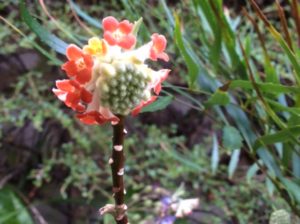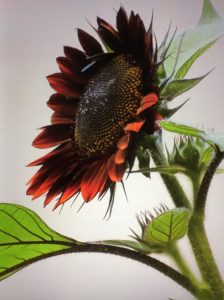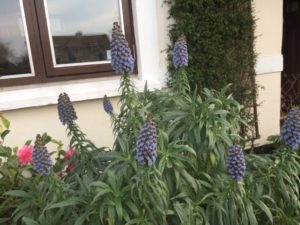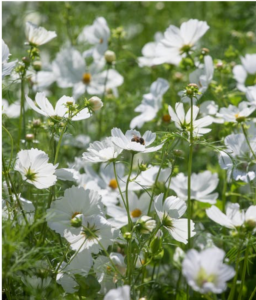April In Our Gardens by Philippa Thomas.
Nature’s clock is ticking away and April is possibly, the busiest time in the garden. Maybe, get your wellies on as Spring has really sprung, at last. Let’s not panic, – one step at a time and enjoy. Expect the inevitable April showers this month but with sunny days too, it is an exciting month with indoor sown seeds well into growth and it’s also the time to start sowing outdoors -, just watch out for frost.
- Edgeworthia Chrysantha ‘Red Dragon’, Paper Bush. The Stems Of This Deciduous Shrub Are Tipped With Domed Clusters Of Woolly White Buds Which Open To Tubular Red Flowers In Early Spring, Frost Hardy, Well-Drained Soil./China And The Himalayas.
The latest plant name to change is Rosmarinus Officinalis and is now more correctly known as Salvia Rosmarinus. This change comes as botanists who always regarded Rosemary and Salvia as very close relatives, have decided that a difference in their stamens wasn’t enough to make them separate plant types. Then, a new labelling system on compost bags will soon tell you how environmentally and ethically responsible the product inside is. It will see all compost bags carry an RSS logo and an A – G rating, similar to energy labels found on household appliances.
…Left unpruned, Lavender will make long, woody plants that often become bare in the centre. To keep them looking good, cut off the old flowering spikes and 2cm off the top of the leaves.
…For our Sunflower lovers ‘Helianthus’, there is a fabulous new stand out variety, deep red Sunflower with rich burnished bronze, velvety petals with a gold fleck, ‘Chianti’. It doesn’t need staking, it has multi flowers that are pollen free and is ideal for cutting.
- New, Deepest Red Sunflower Chianti. Wine-Red Velvet Petals Are Flecked With Gold. Dramatic, Pollenless, Multi Branched And Purple-Stemmed.
We well know in this 2020, that nature hugely benefits our wellbeing, nature is so, so good for us. Researchers in Edinburgh found people living close to a green space had lower levels of stress hormone cortisol, so the less nature we have with our habitat -, the more negative effect on our anxiety and stress. Perhaps, reflecting on this, why not create a ‘GARDEN MINDFULNESS CORNER’ of your very own. Maybe create an area where you can sit alone with friends and family. Perhaps, try to make room for plants which attract butterflies, bees and wildlife to distract from everyday life. Maybe, lose yourself in a floral escape, to a space, a labyrinth filled with fragrance and colour. – It will be loved remember too, by pollinators. Some phloxes have irresistible scent – you could have your very own sanctum with simply sculptural plants or an overabundance of sumptuous roses or simply, Feng Shui. Even your balcony can be a treasure trove -, a living picture of green life. Maybe, you have a view of a tree in a far away neighbours back garden. Why not capitalise?
- Echium Candicans With Grey-Hairy Lance Shaped Leaves, Bees And Other Pollinators Absolutely Adore Echiums.
Consider creating a picture frame of it with a mirror, arch, double trellis, – ‘whatever’ – sort of inviting a window to nature. If you have no garden, no balcony, no outdoor space at all -, why not bring nature indoors. You can make a mindfulness corner in your apartment, bringing greenery into these spaces. Even a green painted wall can be thought provoking, cooling and can enhance your greenery. A couple of interesting Palms, Ferns, a Cymbedium, an Aspidistra, Spider Plants, Zamioculas – ‘Zanzibar Gem’, Peace Lily, Aloes, Succulents all require so little maintenance. Scent again, is sensational – there is actually scientific evidence linking Lavender to calm and to sleep, some of these plants purify the air too. Then, colour and its hues, have an impact on us emotionally and then, the intensity of a colour seems to have even more of an impact. “The brighter the colours the more impact they have on our emotions” -. Professor Alistair Griffiths R.H.S.
- Jasminum Polyanthum, Scented Indoor Jasmine, Still In Flower.
All our lives are better for even the smallest amount of grow-your-own salads, herbs, leafy greens and edible flowers. …If you’re simply not into growing some veg, maybe buy a few grow bags and perhaps consider trying out some cucumbers, tomatoes, aubergines, chillis, peppers, melons, radishes sown in most mild conditions can be eaten within three weeks or so. …As you plant directly into the bag, you can do without a pot and you don’t have to worry about diseased soil in your greenhouse beds. Grow bags are often cheaper than other kinds of compost and grow bags are loved by experienced gardeners too. Before you plant, shake the bag to fluff up the compost and make sure you have cuts in the bottom of the bag to allow excess water to drain out. Water regularly, so the bag doesn’t dry out. In hot weather, this may need to be up to three times a day.
If you choose to sow no other seed, let it be Cosmos Bipinnatus Purity, – honestly it is the perfect bloom with its simple, pure clean white flowers; its egg yolk centres are stuffed full of nectar and pollen and then, its bright green deeply serrated leaves. – So as soon as the sun shines, they are heaving with bees. Its seed germinates almost overnight given a little basal heat. It is absolutely excellent in the garden, flowers ‘til October and is just as good as an elegant cut flower in a vase.
- Cosmos Bipinnatus, Purity. As Soon As The Sun Shines, They Are Heaving With Bees.
Sometimes, self-sowers give the flow of informality and of course, extend our seasons. Then Sarah Raven says, “Without her annuals; her garden would be an orchestra without its string section – they’re the essential ingredients”. Then, annuals too can be used as climbers, such as Rhodochiton, Purple bell, Cobea Scandens, Cup and Saucer plant. What about ‘Love in a Puff’ vine, Cardiospermum? You can have a sumptuous overabundance -, prolific varieties to give you scale and diversity and then, long lasting viridescent impact, zaps of sharp green to add to your haven. As a small child I was one of seven children, we were all given at one stage, a little patch to grow a special choice of ‘easy to grow seeds’ – I used to lose myself, sometimes telling stories while decorating old dank tree trunks and their every creeping crevice with beautiful, soft, velvety moss, lichens, early Spring flowers – making them into fairy forts, palaces, May altars etc.
- Clematis Viticella,’Frances Rivis’, One Of The First To Bloom, Disease Resistant.
Might Do, Maybe April Jobs.
- This is our last chance to cut back shrubs, especially those grown for colourful Winter stems, such as Dogwoods, Willow and gentle pruning of sacred bamboos/heavenly bamboos.
- Refresh the top layer of compost in long-term pots such as Agapanthus with fresh compost that has been mixed with control-release feed.
- If you have any space in the greenhouse around potential tomato beds, directly sow a pack of Zinnia seeds. They’ll give you vases of flowers to pick through the Summer.
- Paperwhites are not hardy but please don’t chuck them out, keep the bulbs for planting again, next Autumn. Maybe, make a partially shaded bed and put all your other used bulbs there and fertilise them. They will be great for years to come.
- This Relative Of A Bussy Lizzie, Impatiens Overwintered….A Lady On Our Visit To Hidcote UK, Gave Me A Tiny Cutting…..It Is Now Approx 2 Feet Tall, Each Flower Has A Pale Pink Splotch In Its Centre.
A major study led by The University of Edinburgh has discovered that some weeds produce more nectar and pollen and produce it, earlier in the year than cultivated plants, making them valuable for wildlife. Three of the top pollen producers are Thistles, Dandelions and Ragworts.
“April hath put a spirit of youth in everything.”
William Shakespeare.
“April prepares her green traffic light and the world thinks, go.”
Christopher Morley.
“Every Spring is the only Spring – , a perpetual astonishment.”
Ellis Peters.







